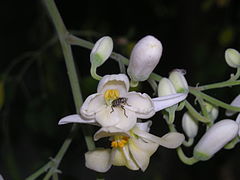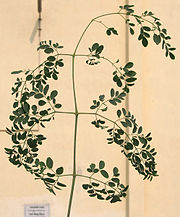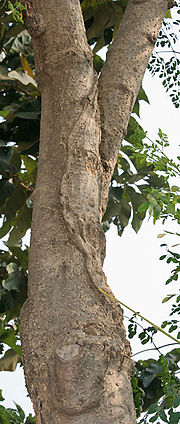
Moringa oleifera
Background to the schools Wikipedia
SOS believes education gives a better chance in life to children in the developing world too. SOS Children has looked after children in Africa for forty years. Can you help their work in Africa?
- "Drumstick Tree" and variants thereof redirect here. This name is also used for the Golden Shower Tree (Cassia fistulosa L.).
| Moringa oleifera | |
|---|---|
 |
|
| Scientific classification | |
| Kingdom: | Plantae |
| Division: | Magnoliophyta |
| Class: | Magnoliopsida |
| Order: | Brassicales |
| Family: | Moringaceae |
| Genus: | Moringa |
| Species: | M. oleifera |
| Binomial name | |
| Moringa oleifera |
|
Moringa oleifera, commonly referred to simply as Moringa (Tamil murungai, முருங்கை), is the most widely cultivated variety of the genus Moringa. It is of the family Moringaceae. It is an exceptionally nutritious vegetable tree with a variety of potential uses. The tree itself is rather slender with drooping branches that grows to approximately 10 m in height; however, it normally is cut back annually to one meter or less, and allowed to regrow, so that pods and leaves remain within arm's reach.
The Moringa tree grows mainly in semi-arid tropical and subtropical areas, corresponding in the United States to USDA hardiness zones 9 and 10. While it grows best in dry sandy soil, it tolerates poor soil, including coastal areas. It is a fast-growing, drought-resistant tree that is native to the southern foothills of the Himalayas, and possibly Africa and the Middle East. Today it is widely cultivated in Africa, Central and South America, Sri Lanka, India, Mexico, Malaysia and the Philippines. Considered one of the world’s most useful trees, as almost every part of the Moringa tree can be used for food, or has some other beneficial property. In the tropics it is used as foliage for livestock.
The immature green pods, called “drumsticks” are probably the most valued and widely used part of the tree. They are commonly consumed in India, and are generally prepared in a similar fashion to green beans and have a slight asparagus taste. The seeds are sometimes removed from more mature pods and eaten like peas or roasted like nuts. The flowers are edible when cooked, and are said to taste like mushrooms. The roots are shredded and used as a condiment in the same way as horseradish, however it contains the alkaloid spirochin, a potentially fatal nerve paralyzing agent, so such practices should be strongly discouraged.
The leaves are highly nutritious, being a significant source of beta-carotene, Vitamin C, protein, iron and potassium. The leaves are cooked and used like spinach. In addition to being used fresh as a substitute for spinach, its leaves are commonly dried and crushed into a powder, and used in soups and sauces. Murungakai as it is locally known in Tamil Nadu and Kerala is used in Siddha medicine. Its leaves are full of medicinal properties. The tree is a good source for calcium and phosphorus. In Siddha medicine, the drumstick seeds are used as a sexual virility drug for treating erectile dysfunction in men and also in women for prolonging sexual activity.
The Moringa seeds yield 38–40% edible oil (called ben oil, from the high concentration of behenic acid contained in the oil) that can be used in cooking, cosmetics, and lubrication. The refined oil is clear, odorless, and resists rancidity at least as well as any other botanical oil. The seed cake remaining after oil extraction may be used as a fertilizer or as a flocculent to purify water.
The bark, sap, roots, leaves, seeds, oil and flowers are used in traditional medicine in several countries. In Jamaica, the sap is used for a blue dye.
The flowers are also cooked and relished as a delicacy in West Bengal and Bangladesh, especially during early spring. There it is called sojne ful and is usually cooked with green peas and potato.
Cultivation
In India, the plant is propagated by planting limb cuttings 1–2 m long, from June to August, preferably. The plant starts bearing pods 6–8 months after planting but regular bearing commenced after the second year. The tree bears for several years. It does not tolerate freezes or frost. It can also be propagated by seed. As with all plants, optimum cultivation depends on producing the right environment for the plant to thrive. Moringa is a sun and heat loving plant. As a seedling, however, you must monitor the environment in the beginning until the tree is established. Seeds can be germinated year round.
Culinary uses
The fruit of the tree is quite popular as a vegetable in Asia and Africa. The fruit is a long, thin pod, resembling a drum stick. The fruit itself is called drumstick in India and elsewhere. Moringa leaves are also eaten as a leaf vegetable, particularly in the Philippines and Africa.
India
The moringa pod is known as drumstick or saragwa or saragwe in India. In South India, it is used to prepare a variety of sambar and is also fried. It is also preserved by canning and exported worldwide. In other parts of India, especially West Bengal and also in a neighboring country like Bangladesh it is enjoyed very much. It can be made into varieties of curry by mixing with coconut, poppy seeds and mustard. It can just be boiled, until the drumsticks are semi-soft and consumed directly without any extra processing or cooking. It is used in curries, sambars, kormas, and dals, although it is also used to add flavor to cutlets, etc.
Tender drumstick leaves, finely chopped, make an excellent garnish for any vegetable dishes, dals, sambars, salads, etc. One can use the same in place of or with coriander, as these leaves have high medicinal value. If the pulp has to be scraped out after cooking the sticks, then keep the pieces as long as 4-5 inches long. Also do not scrape the skin before boiling. This will help to hold and scrape them more easily and with less mess. For drumstick sambar follow recipe for traditional sambar, adding boiled drumstick fingers, along with onions in the oil, while stir frying.
Scraped drumstick pulp can be made into drumstick bhurtha, more or less like the baingan bhurtha after the pulp has been obtained. It is a wonderfully unusual and tasty dish. The recipe is identical to that of baingan bhurtha.
Drumstick dal, is also a very tasty version of the traditional ' toor dal'. Add some of the pulp to the boiled dal, and hand beat it along with the dal before seasoning. This will give an unusual, novel flavor to this dal. In another variation you may add pieces of boiled drumstick including the water in which it was boiled, to the traditional toor dal while it is simmering. The pieces are delightful to chew on with the dal & rice. In addition to being known as Drumstick Dal, the South Indian version which is a spiced lentil soup is more popular by the name - sambar or sambhar. Sambar is usually cooked with toor dal, drumsticks and other locally grown vegetables. The spices used typically in this stew are turmeric, chili powder and cumin among others. It is eaten with rice just like the Drumstick dal.
Philippines
In the Philippines, the leaves are widely eaten. Bunches of leaves are available in many markets, priced below many other leaf vegetables. The leaves are most often added to a broth to make a simple, and highly nutritious soup. The leaves are also sometimes used as a characteristic ingredient in tinola—a traditional chicken dish, composed of chicken in a broth, moringa leaves, and either green papaya or another secondary vegetable.
The leaves are now used in making "polvoron" candy, as bio-fuel and morinaga oil.
On September 14, 2007, Senator Loren Legarda campaigned for the popularization of moringa. She asked the government to make moringa among its priority crops for propagation. The Bureau of Plant Industry, in its report, stated that, weight per weight, moringa leaves have the calcium equivalent of 4 glasses of milk, the vitamin C content of 7 oranges, potassium of 3 bananas, 3 times the iron of spinach, 4 times the amount of vitamin A in carrots, and 2 times the protein in milk. Moringa also helps to purify water, a cheaper alternative to mechanical filtration.
Other uses
The tree's bark, roots, fruit, flowers, leaves, seeds and gum are also used medicinally in India. Uses include as an antiseptic and in treating rheumatism, venomous bites and other conditions. The moringa seed pod is also used to cleanse water (e.g. desalination of ocean salt water).
Names
Other names for the Moringa in English include:
- Drumstick tree, from the appearance of the long, slender, triangular seed pods.
- Horseradish tree, from the taste of the leaves, which can serve as a rough substitute for horseradish.
- Ben oil tree, from the oil derived from the seeds
The Chinese name of the Moringa (辣木), pronounced "la mu" in Putonghua and "lat mok" in Cantonese, means "spicy (hot) wood", and is reminiscent of the English name "horseradish tree".
In some Indian languages, the name is phonetically somewhat similar to "moringa", while in others it is quite different:
- In Thai language it is called "ma rum มะรุม".
- In Assamese it is called Sojina.
- In Hindi it is called Surajana.
- In Tamil it is called Murungakka in singular form, the plural form being Murungakkai.
- In Hindi it is called sahjan.
- In Marathi is it called Shevga.
- In Kannada it is known as Nuggaeekayee.
- In Tulu it is known as Noorggaee.
- In Telugu it is called Mulakkaya.
- In Gujarati is it called Saragvo.
- In Oriya it is called Sajana or Sujuna.
- In Bengali it is called Sojne danta.
- In Kerala state its known as Muringa Tree and the fruit called Muringakka in Malayalam.
- In Nepali it is known as Sajiwan or Swejan.
- In Guyana it is called Saijan
The Tagalog name, in the Philippines - Malunggay - is also phonetically similar to "moringa". In Ilocano, another Filipino language, its called Marungay. It is called "Kamunggay" in Bisaya.
In Haiti, the moringa is called the benzolive (or benzolivier).
In Nicaragua the plant is referred to as Marango.
In Indonesian, the moringa is called kelor (kalor in Malay). In Javanese, it is called limaran.
The MMPND entry for Moringa gives names in many other languages.
Popular beliefs
There are several popular beliefs associated with the tree and the fruit in southern India.
- The fruit is said to increase sexual libido in men. This belief is so common in the state of Tamil Nadu that there have been passive references to this in its legislative assembly.
- The tree is said to host ghosts during the night. This combined with the fact that the tree attracts a host of insects make it unattractive for people to grow it in their backyards.




